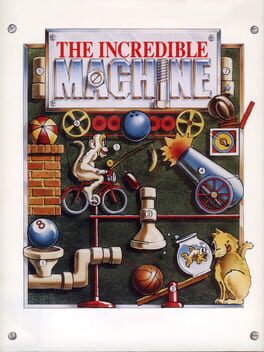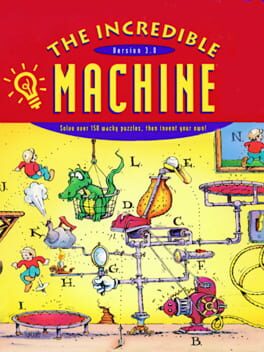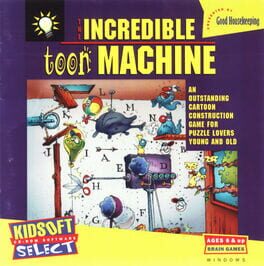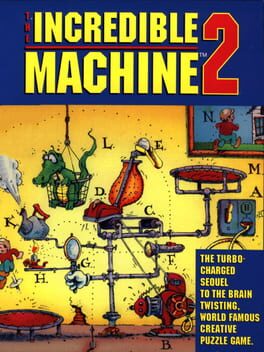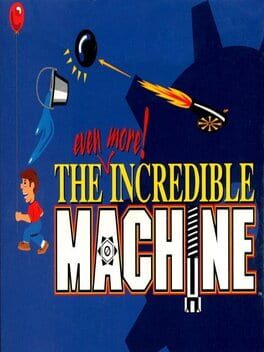

The Incredible Machine is a puzzle game. You have to solve different puzzles by building the incredible machine. You have predefined quantity of given building blocks and you have to build the machine to finish a simple goal. There are many different building blocks like ropes, pulleys, electrical generators, bowling balls, cats, mice and many more. The levels usually have some fixed objects that cannot be moved by the player, so you have to arrange the given building blocks around the fixed items.
Also in series
Reviews View More
Played during the Backloggd’s Game of the Week (5th Aug. – 11th Sep., 2023).
The origins of The Incredible Machine are shrouded in a degree of uncertainty, as interviews with its creators, Jeff Tunnell and Kevin Ryan, are difficult to trust. An article by Jimmy Mayer led to a discussion that found an obvious aesthetic similarity between The Incredible Machine and an earlier game, Creative Contraptions (1985) [1]. Although the technical limitations of the latter make it rather rudimentary, The Incredible Machine is certainly inspired by it, both in its colour palette and in some of the mechanisms used. Shamefully, this inspiration was never mentioned by Tunnell or Ryan, who were perhaps too concerned with basking in the laurels of their creation or asserting their fame and legitimacy. Nevertheless, the title remains impressive, with its then-sophisticated physics engine providing a naturally creative experience.
While comedies of the 1980s and 1990s often featured Rube Goldberg's machines for their absurdly complex structure, The Incredible Machine uses the concept to test causal reasoning – as in Creative Contraptions – and to present some axioms of Newtonian physics. The various levels gradually introduce the different objects of the game, without ever forcing the player's hand, but rather letting them experiment. The player is free to experiment and understand, by running the simulation several times and adjusting the various components, how the different mechanisms can be triggered, the role of gravity, the parity of the gears and other ideas. This trial and error contributes to a childlike sense of wonder that works remarkably well. In one stage, the player has to undo a pattern of ropes: the exercise is not particularly difficult, but there is something hypnotic about watching the rope weave realistically through the air, following wide interlaced loops. While it is possible to modify gravity or ambient pressure, The Incredible Machine sometimes strays from real physics to facilitate certain puzzles: the trampolines strangely assume that an object gains energy after a bounce, and the seesaws hardly respect Newton's third law.
However, these discrepancies could be understood as a deliberate attempt to widen the range of possibilities. Some levels imply a natural solution using all the tools in your inventory, while others are much more open. The player can use or ignore the mechanisms already placed on the board: solving a puzzle in an extremely minimalist way, taking advantage of the physics engine and carefully thought-out bounces, is not uncommon, as the model is always deterministic. This plasticity is echoed in the Freeform mode, where imagination is the only boundary: impressive – if unrealistic – perpetual motion can be created among other complex contraptions. This philosophy of wonder, creativity and experimentation was later reflected in Zachtronics' productions, which are also concerned with this didactic aspect. Anecdotally, some of the tracks of Shenzhen I/O (2016) sound surprisingly like The Incredible Machine's 'Euro'. There is something empowering about a title that gives the player all the latitude they need to feel in control of their instruments and their environment. And despite some ergonomic shortcomings, The Incredible Machine still manages to capture that magical feeling.
__________
[1] On the influences of Mouse Trap (1963) and the discussion surrounding the origins of the game, see Jimmy Maher, 'The Incredible Machine', on The Digital Antiquarian, 8th June 2018, consulted on 11th September 2023.
The origins of The Incredible Machine are shrouded in a degree of uncertainty, as interviews with its creators, Jeff Tunnell and Kevin Ryan, are difficult to trust. An article by Jimmy Mayer led to a discussion that found an obvious aesthetic similarity between The Incredible Machine and an earlier game, Creative Contraptions (1985) [1]. Although the technical limitations of the latter make it rather rudimentary, The Incredible Machine is certainly inspired by it, both in its colour palette and in some of the mechanisms used. Shamefully, this inspiration was never mentioned by Tunnell or Ryan, who were perhaps too concerned with basking in the laurels of their creation or asserting their fame and legitimacy. Nevertheless, the title remains impressive, with its then-sophisticated physics engine providing a naturally creative experience.
While comedies of the 1980s and 1990s often featured Rube Goldberg's machines for their absurdly complex structure, The Incredible Machine uses the concept to test causal reasoning – as in Creative Contraptions – and to present some axioms of Newtonian physics. The various levels gradually introduce the different objects of the game, without ever forcing the player's hand, but rather letting them experiment. The player is free to experiment and understand, by running the simulation several times and adjusting the various components, how the different mechanisms can be triggered, the role of gravity, the parity of the gears and other ideas. This trial and error contributes to a childlike sense of wonder that works remarkably well. In one stage, the player has to undo a pattern of ropes: the exercise is not particularly difficult, but there is something hypnotic about watching the rope weave realistically through the air, following wide interlaced loops. While it is possible to modify gravity or ambient pressure, The Incredible Machine sometimes strays from real physics to facilitate certain puzzles: the trampolines strangely assume that an object gains energy after a bounce, and the seesaws hardly respect Newton's third law.
However, these discrepancies could be understood as a deliberate attempt to widen the range of possibilities. Some levels imply a natural solution using all the tools in your inventory, while others are much more open. The player can use or ignore the mechanisms already placed on the board: solving a puzzle in an extremely minimalist way, taking advantage of the physics engine and carefully thought-out bounces, is not uncommon, as the model is always deterministic. This plasticity is echoed in the Freeform mode, where imagination is the only boundary: impressive – if unrealistic – perpetual motion can be created among other complex contraptions. This philosophy of wonder, creativity and experimentation was later reflected in Zachtronics' productions, which are also concerned with this didactic aspect. Anecdotally, some of the tracks of Shenzhen I/O (2016) sound surprisingly like The Incredible Machine's 'Euro'. There is something empowering about a title that gives the player all the latitude they need to feel in control of their instruments and their environment. And despite some ergonomic shortcomings, The Incredible Machine still manages to capture that magical feeling.
__________
[1] On the influences of Mouse Trap (1963) and the discussion surrounding the origins of the game, see Jimmy Maher, 'The Incredible Machine', on The Digital Antiquarian, 8th June 2018, consulted on 11th September 2023.
Alright, let's see how it goes.
The candle falls down on the trampoline just to hit the hamster wheel that's connected to the conveyor belt next to it, now if it keeps the momentum juuuuuust right it might be able to get to the hamster wheel at the end of the platfo- oh yeah that's nice it's falling down on the other conveyer belt that's connected to set of gears, it's jumpingonthetrampolinenexttoitHOLYSHITIT'SGONNATOUCHTHEFIVEBALLOONSCOMEONCOMEONCOMEONCOMEONLET'SGOOOOOOOOO!!!!!
This is your usual The Incredible Machine puzzle.
Aren't Rube Goldberg machines fun ?
The ridiculously and overly complex system to perform a simple task has always been both a form of comic relief as well as a strangely captivating and addictive device.
Puzzle games almost entirely rely on an eureka effect, an example of clever game design and level design (assuming the said puzzle is based on an original mechanic) would usually be to keep the answer straightforward and easy to understand while simultaneously making the player scratch their head, it has to be complex, not complicated.
Why are you solving this puzzle ? To get to experience that eureka effect, the carrot and the stick, you know.
Not only does The Incredible Machine manage to succeed in all of the above, it also goes even further by making the actual problem-solving incredibly fun. It does not restrain in order to deliver a bigger dopamine shot, it builds up to it.
Whereas physics puzzles often leave room for experimentation, here, it is ABOUT experimentation, even though your machine might not actually get you to the answer, the simple fact of piecing it up little by little and testing is entertainment by itself, and is something the lead developer Kevin Ryan was very aware of by adding a free mode just to build things without any goal in mind.
Looking down at some YouTube comments, it's a game that seems to have been an important part of 90s kids' childhood (for quite obvious reasons) and is also one that amazed me the very same way over two decades later, now if that's not incredible.
The candle falls down on the trampoline just to hit the hamster wheel that's connected to the conveyor belt next to it, now if it keeps the momentum juuuuuust right it might be able to get to the hamster wheel at the end of the platfo- oh yeah that's nice it's falling down on the other conveyer belt that's connected to set of gears, it's jumpingonthetrampolinenexttoitHOLYSHITIT'SGONNATOUCHTHEFIVEBALLOONSCOMEONCOMEONCOMEONCOMEONLET'SGOOOOOOOOO!!!!!
This is your usual The Incredible Machine puzzle.
Aren't Rube Goldberg machines fun ?
The ridiculously and overly complex system to perform a simple task has always been both a form of comic relief as well as a strangely captivating and addictive device.
Puzzle games almost entirely rely on an eureka effect, an example of clever game design and level design (assuming the said puzzle is based on an original mechanic) would usually be to keep the answer straightforward and easy to understand while simultaneously making the player scratch their head, it has to be complex, not complicated.
Why are you solving this puzzle ? To get to experience that eureka effect, the carrot and the stick, you know.
Not only does The Incredible Machine manage to succeed in all of the above, it also goes even further by making the actual problem-solving incredibly fun. It does not restrain in order to deliver a bigger dopamine shot, it builds up to it.
Whereas physics puzzles often leave room for experimentation, here, it is ABOUT experimentation, even though your machine might not actually get you to the answer, the simple fact of piecing it up little by little and testing is entertainment by itself, and is something the lead developer Kevin Ryan was very aware of by adding a free mode just to build things without any goal in mind.
Looking down at some YouTube comments, it's a game that seems to have been an important part of 90s kids' childhood (for quite obvious reasons) and is also one that amazed me the very same way over two decades later, now if that's not incredible.
